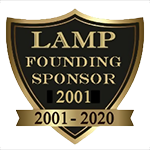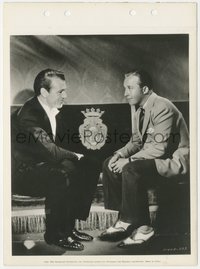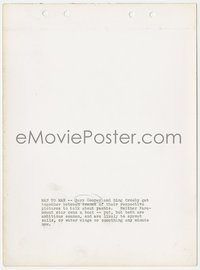eMoviePoster.com
Auction History Result 7b1406 GARY COOPER/BING CROSBY 8x11 key book still 1934 talking about yachts between scenes! Date Sold 8/27/2024Sold For: Login or Register to see sold price. An Original Vintage 8 1/4" x 11" [21 x 28 cm] Key Book Still (Learn More) Gary Cooper was born Frank James Cooper in Helena, Montana, USA in 1901. His mother was English born, and he and his brother were sent to an English boarding school to be educated when they were young, but when WWI broke out, they were brought home. His father was a judge who also owned a ranch, and Cooper went to college, but did not graduate, and ran his father's ranch afterwards, and also drew some cartoons for the local paper. When he was 23 his father left the bench and sold the ranch and his parents moved to California, and because Cooper could not make a living at his cartooning, he moved with them. After a year of odd jobs, he started getting extra roles in movie westerns. He signed a contract with Paramount, and changed his first name to Gary. Cooper got progressively better roles in non-talkie movies, and had romances with some of his more famous co-stars, including Clara Bow and Lupe Velez. In 1927, he played a small, but important role of a doomed flyer in Wings, which was a major breakthrough for him, and led to many better starring roles the following year. In 1929 he starred as the title character in The Virginian, which was made in both a talkie and non-talkie version. He had become the man that women everywhere swooned over, and men wanted to be like him. In 1930 he starred in Morocco, opposite Marlene Dietrich, and in 1932 he was hand picked by Hemingway to star in A Farewell to Arms, and in 1936 he starred in Frank Capra's Mr. Deeds Goes To Town (nominated for the Best Actor Academy Award for this film). He had his pick of movies, and many of the ones he turned down were then offered to similar actor Joel McCrea, who basically lived in Cooper's shadow throughout the 1930s. He turned down the lead role in Capra's Mr. Smith Goes to Washington (it started out as a Mr. Deeds sequel), and James Stewart got the role. He turned down the lead in Stagecoach, and that part made John Wayne a major star after toiling in B-westerns for many years. His greatest blunder was turned down the role of Rhett Butler in Gone with the Wind. He said at the time, "Gone with the Wind is going to be the biggest flop in Hollywood history. I'm glad it'll be Clark Gable who' falling flat on his nose, not me"! In 1941, Alvin York, the most decorated soldier in WWI, finally agreed to a movie being made of his life (to help recruiting efforts in WWII), but he insisted that only Cooper could play him, and Cooper won his first Oscar for that role in Sergeant York. The next year Lou Gehrig tragically died, and Cooper played him superbly in The Pride Of The Yankees (nominated for the Best Actor Academy Award for this film), and his "Today I am the luckiest man on the face of the Earth" speech is one of the great moments in movie history! He was Robert Jordan in Hemingway's For Whom The Bell Tolls (nominated for the Best Actor Academy Award for this film), and Ayn Rand picked him to play Howard Roark in The Fountainhead. In 1952 he had one of the finest roles of his career, as Will Kane in High Noon, and he won a second Oscar. In 1960 he got prostate cancer, and he died the following year, at 60 years of age. There will never be another star like Gary Cooper! He stayed a major leading actor for 25 solid years, starring in around 90 movies, and during that time he was the lead in important movies of all sorts, because so many writers, directors, and co-stars wanted him for their star! I highly recommend all the movies noted above, but you really can't go wrong with any Gary Cooper movie, for his presence elevated even his lesser movies into something worth watching! AND Bing Crosby was born Harry Lillis Crosby in Tacoma, Washington in 1903, in a large working class family. He got the nickname "Bing" when he was 10. He went to college, intending to become a lawyer, but he joined a local band as a drummer, and he quit school in his last year. In 1926, he was spotted by Paul Whiteman, and was hired, along with his partner, Al Rinker. Whiteman added Harry Barris, and named them the Rhythm Boys, and they were a big hit. Crosby was the star of the act, and in 1931 he split from the group, and went solo. He was the number one recording star of the 1930s, and his distinctive style of singing was dubbed "crooning". He had done some singing in movies with the Rhythm Boys at the start of the 1930s, but he soon starting playing dramatic roles in musicals, and was a natural, likable performer, and was very successful in movies in the 1930s. In 1940 he teamed with Dorothy Lamour and Bob Hope for the first of the very successful "Road" movies, Road to Singapore. When the U.S. entered WWII. he added to his huge popularity by doing much entertaining of the troops. In 1942, he sang White Christmas on his radio show and used it in his movie, Holiday Inn (it would be re-used in the partial re-make of Holiday Inn, White Christmas, in 1954). In 1944 he made his greatest movie, Going My Way (winner of the Best Actor Academy Award for this film), which was followed by The Bells Of St. Mary's (nominated for the Best Actor Academy Award for this film). In 1954, he also starred in The Country Girl (nominated for the Best Actor Academy Award for this film). In 1956 he was in High Society, the musical re-make of The Philadelphia Story. Bing Crosby was among the very best selling singers of all time, and also was among the absolute biggest box office draws at the movies! There is no other singer who had as much success as he did in the movies, or vice versa! He passed away in 1977 at the age of 74. Important Added Info: Note that this cool candid shows two of Paramount's greatest stars discussing the yacht they hoped to buy! Note that this still is a key book still, printed on a deluxe heavyweight paper stock. Many studios spent extra money to have their most special photos, the key book stills, either backed with linen or printed on a heavy paper, both of which enhanced their durability. They had an extra 1" at the left or top, with punch holes, because of how they were stored. Key book stills are far more rare than regular stills, which has increased their popularity among collectors, since only a few keybooks were manufactured per film, and a key book still is guaranteed to be authentic. Condition: very good to fine. Learn More about condition grades 

Postal Mailing Address:
Bruce Hershenson, P.O. Box 874, West Plains, MO 65775. (For our UPS or FedEx address, click here) phone: +1 417 256-9616 fax: +1 417 257-6948 E-mail: Contact Us Hours of Operation: Monday - Friday 8:30 AM - 12:00 PM & 1:00 PM - 5:00 PM (CST) |
|||||||||||||







